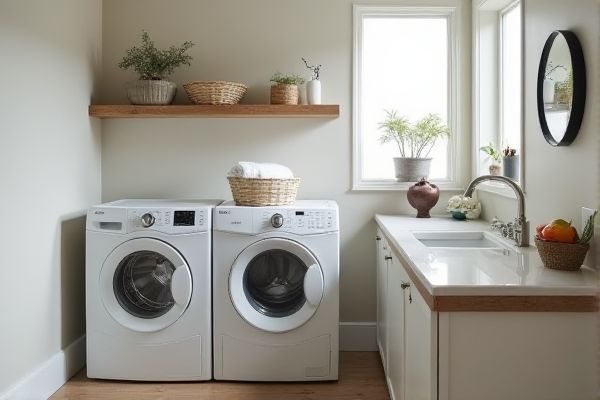
A utility sink is designed for heavy-duty cleaning tasks like washing tools, while a laundry sink is primarily used for soaking and hand-washing clothes; both serve distinct purposes in maintaining a functional laundry or utility room. Discover the key differences and how to choose the right sink for your needs by reading the full article.
Table of Comparison
| Feature | Utility Sink | Laundry Sink |
|---|---|---|
| Primary Use | Heavy-duty cleaning, tool washing, outdoor tasks | Washing clothes, soaking laundry, pre-treating stains |
| Material | Durable materials like stainless steel or heavy plastic | Porcelain, plastic, or composite materials |
| Size | Larger and deeper for bulky items | Moderate size, suitable for laundry tubs |
| Location | Garage, basement, outdoor work areas | Laundry rooms, utility rooms |
| Features | High backsplash, deep basin, heavy-duty faucet | Drainboard option, softer basin edges |
| Cost | Typically higher due to durability | Generally more affordable |
| Installation | Requires strong support and durable plumbing | Standard plumbing suited for laundry tasks |
Introduction to Utility Sinks and Laundry Sinks
Utility sinks and laundry sinks serve distinct yet overlapping functions in household and commercial settings. Utility sinks are designed for heavy-duty cleaning tasks, often found in garages or workshops, with deeper basins to accommodate large items and tools, while laundry sinks are typically located in laundry rooms, optimized for washing delicate clothing and pre-treating stains. Your choice between the two should consider the specific cleaning needs, space availability, and the type of tasks you perform most frequently.
Key Differences Between Utility and Laundry Sinks
Utility sinks are designed for heavy-duty tasks, featuring deeper basins and durable materials like stainless steel or heavy-duty plastic to handle cleaning tools, paint, and outdoor gear. Laundry sinks typically have shallower basins and smooth surfaces ideal for handwashing clothes or pre-treating stains, often installed near washers for convenience. The primary difference lies in their intended use: utility sinks accommodate more rugged, multipurpose cleaning tasks, while laundry sinks focus on garment care and laundry-related activities.
Common Materials Used in Utility and Laundry Sinks
Utility sinks and laundry sinks are commonly made from durable materials such as stainless steel, acrylic, and molded plastic to withstand heavy use and chemical exposure. Cast iron with enamel coatings is frequently used for laundry sinks, offering long-lasting durability and resistance to stains. Fiberglass and composite materials also serve as popular choices for utility sinks due to their lightweight nature and impact resistance.
Size and Design Considerations
Utility sinks typically offer larger basins and deeper bowls designed for heavy-duty tasks like cleaning large tools or soaking bulky items, while laundry sinks generally feature moderate depth suited for washing clothes and smaller household chores. The design of utility sinks prioritizes durability with materials like stainless steel or heavy-duty plastic, whereas laundry sinks often incorporate more stylish finishes and ergonomic designs to fit laundry room aesthetics. Your choice depends on the available space and specific cleaning needs, balancing size and functionality for maximum convenience.
Installation Options: Utility vs. Laundry Sinks
Utility sinks often offer versatile installation options, including wall-mounted, freestanding, and drop-in configurations suitable for workshops or garages. Laundry sinks typically come as freestanding or countertop models designed for laundry rooms, with built-in shelves or cabinets for storage. Choosing between them depends on space availability, plumbing setup, and specific utility needs within your home or workspace.
Functionality and Primary Uses
A utility sink is designed for heavy-duty tasks such as cleaning tools, washing large items, and managing messy projects, making it essential in workshops and garages. A laundry sink primarily supports clothing care, including pre-soaking stains, hand-washing delicate garments, and rinsing out detergents. Both sinks offer deep basins and durable materials, but utility sinks handle broader functions while laundry sinks focus on fabric care.
Durability and Maintenance Needs
Utility sinks are typically constructed from heavy-duty materials like stainless steel or cast iron, offering superior durability for tough cleaning tasks and high resistance to stains and scratches. Laundry sinks, often made from plastic or enamel-coated steel, require gentler maintenance to prevent cracking or chipping but provide adequate durability for everyday washing and soaking. Both sink types benefit from routine cleaning, but utility sinks demand less frequent repairs due to their robust construction, making them ideal for heavy use environments.
Cost Comparison: Utility Sink vs. Laundry Sink
Utility sinks generally cost more than laundry sinks due to their larger size and heavy-duty construction designed for tougher cleaning tasks. Laundry sinks are typically more affordable and easier to install, making them a budget-friendly option for routine laundry needs. Choosing the right sink depends on your specific usage and budget, with utility sinks offering more durability for higher investment.
Choosing the Right Sink for Your Space
Choosing the right sink for your space depends on the intended use and available area; utility sinks are typically larger, deeper, and designed for heavy-duty tasks like cleaning tools or soaking clothes, while laundry sinks are often more compact and tailored for washing delicate garments or hand-washing needs. Consider your daily activities and space constraints to select a sink that balances functionality and convenience. Ensuring your chosen sink meets your workflow will enhance efficiency and maintain cleanliness in your utility or laundry room.
Final Verdict: Which Sink Suits Your Needs Best?
Utility sinks offer deep basins and durable materials designed for heavy-duty tasks, making them ideal for garages, workshops, or mudrooms. Laundry sinks provide larger, gentler basins specifically tailored for washing clothes and treating stains, perfect for laundry rooms and household chores. Consider your primary usage and workspace to determine if a rugged utility sink or a spacious laundry sink best suits your cleaning and washing needs.
 homyna.com
homyna.com